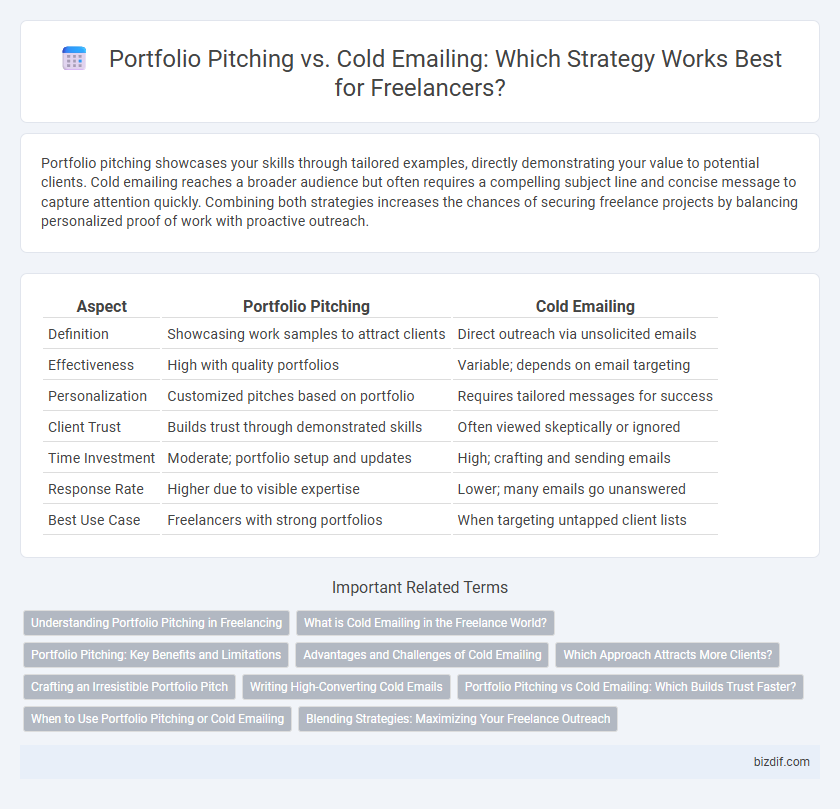Portfolio pitching showcases your skills through tailored examples, directly demonstrating your value to potential clients. Cold emailing reaches a broader audience but often requires a compelling subject line and concise message to capture attention quickly. Combining both strategies increases the chances of securing freelance projects by balancing personalized proof of work with proactive outreach.
Table of Comparison
| Aspect | Portfolio Pitching | Cold Emailing |
|---|---|---|
| Definition | Showcasing work samples to attract clients | Direct outreach via unsolicited emails |
| Effectiveness | High with quality portfolios | Variable; depends on email targeting |
| Personalization | Customized pitches based on portfolio | Requires tailored messages for success |
| Client Trust | Builds trust through demonstrated skills | Often viewed skeptically or ignored |
| Time Investment | Moderate; portfolio setup and updates | High; crafting and sending emails |
| Response Rate | Higher due to visible expertise | Lower; many emails go unanswered |
| Best Use Case | Freelancers with strong portfolios | When targeting untapped client lists |
Understanding Portfolio Pitching in Freelancing
Portfolio pitching in freelancing involves presenting a curated selection of your best work tailored to a potential client's needs, showcasing skills and project outcomes to build trust and demonstrate suitability. This method leverages visual and descriptive evidence of past successes, making it a more personalized and engaging approach compared to generic outreach. Effective portfolio pitching increases visibility, enhances credibility, and significantly improves the chances of securing freelance projects by directly addressing client expectations.
What is Cold Emailing in the Freelance World?
Cold emailing in the freelance world involves reaching out to potential clients via unsolicited emails to promote services and secure projects. This strategy requires crafting personalized, concise messages that highlight relevant skills and past work to capture attention effectively. Cold emailing can expand a freelancer's network and generate leads beyond the reach of portfolio pitching alone.
Portfolio Pitching: Key Benefits and Limitations
Portfolio pitching enables freelancers to showcase their best work visually, making it easier for potential clients to assess their skills and style. It often leads to higher engagement rates compared to cold emailing, as the targeted presentation demonstrates professionalism and relevance. However, portfolio pitching may require more preparation time and is less effective without a clear understanding of the client's preferences or industry demands.
Advantages and Challenges of Cold Emailing
Cold emailing offers direct access to prospective clients, enabling freelancers to scale outreach efficiently without relying on referrals or existing networks. It allows for personalized messaging tailored to specific target industries, increasing the chance of engagement despite low response rates. Challenges include overcoming spam filters, crafting compelling subject lines to boost open rates, and managing follow-ups to nurture potential leads effectively.
Which Approach Attracts More Clients?
Portfolio pitching attracts more clients by showcasing proven skills and past project successes, providing tangible evidence of capability that builds trust. Cold emailing often yields lower response rates due to its impersonal nature and high competition in crowded inboxes. Clients tend to engage more with freelancers who present tailored portfolios demonstrating relevant expertise rather than generic outreach messages.
Crafting an Irresistible Portfolio Pitch
Crafting an irresistible portfolio pitch requires showcasing relevant expertise through concise, visually appealing samples tailored to client needs. Highlight measurable results and unique skills to differentiate from competitors and build trust quickly. Personalizing each pitch with clear value propositions increases response rates compared to generic cold emailing approaches.
Writing High-Converting Cold Emails
Writing high-converting cold emails requires crafting personalized messages that clearly communicate the value proposition and address the recipient's specific pain points. Incorporating compelling subject lines, concise content, and strong calls-to-action significantly increases response rates compared to generic outreach methods. Leveraging data-driven insights and A/B testing can optimize email performance and enhance client acquisition in freelancing.
Portfolio Pitching vs Cold Emailing: Which Builds Trust Faster?
Portfolio pitching builds trust faster than cold emailing by showcasing tangible proof of skills and previous work, allowing potential clients to assess quality and style immediately. Cold emailing often lacks personalization and visible credentials, making it harder to establish credibility quickly. Highlighting a well-crafted portfolio directly addresses client needs and fosters immediate confidence in a freelancer's capabilities.
When to Use Portfolio Pitching or Cold Emailing
Portfolio pitching is ideal when targeting specific clients who value detailed demonstrations of skills and past projects, such as agencies or companies seeking specialized expertise. Cold emailing works best for broader outreach, allowing freelancers to introduce themselves to potential clients with concise, personalized messages that spark initial interest. Choosing between these methods depends on the freelancer's goals, industry, and the level of customization needed to engage prospective clients.
Blending Strategies: Maximizing Your Freelance Outreach
Blending portfolio pitching with cold emailing maximizes freelance outreach by showcasing proven skills while initiating direct contact with potential clients. Tailored emails referencing specific portfolio projects increase engagement rates and demonstrate relevance to client needs. Combining these strategies creates a robust approach that leverages both credibility and proactive communication to secure freelance opportunities.
Portfolio Pitching vs Cold Emailing Infographic

 bizdif.com
bizdif.com